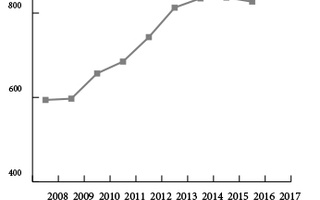The Graduate School of Design’s Gund Hall sticks out among Harvard’s red-brick laden campus. While some might regard the concrete exterior as ugly, some say the interior could serve as a model for a university that lacks central social spaces. Still, others contend that the building’s size and limited availability of workspaces leave certain master's degree students feeling left out.{shortcode-fcceb2fef4d3128991afd0119ba21116aefe2050}
Gund hall currently features a cafeteria, auditorium, fabrication lab, library, classrooms, and offices. At the heart of the building, though, are the four floors of desks, also known as trays, which offer collaborative spaces for nearly 600 studio students. The terraced, open floor plan allows students from the top floor to see the models that students on the mezzanine are designing, and vice-versa. The hope is to foster collaboration and spontaneity.
The Design School’s Director of Facilities Management Kevin W. Cahill said it is commonly known that students spend over 80 hours per week at the school.
“What we have here is different disciplines in the same space so they get to see what each other are doing just by being in the studio. You get to see all the other projects and see what people in other programs are doing as well as people in your program,” Cahill said. “That in itself is a learning experience,” he said.
Beyond the space inside the studio, the school also has built in social spaces on each of the floors.
“No one leaves the building… GSD becomes like a bubble from the middle of the semester until the end,” Masters in Design Studies candidate Aman Singhvi said.“Some people even have this conversation: why are they paying rent to live somewhere else?”
When Gund Hall was conceived nearly 50 years ago, it was designed to serve a much smaller student population, Cahill said. The GSD has grown since then in terms of both the size of student body and number of degree programs.
While the studio provides desks for the Architecture, Landscape Architecture, and Urban Planning and Design programs, the Master in Design Studies program is left without any sanctioned space because the program is not studio-based, according to GSD Communications Manager Travis Dagenais.
The lack of desk space for Master in Design Studies students has been a divisive subject within the program. In the past, students have posted stickers asking “Where are our desks?” around Gund.
Though Singhvi did not participate in the sticker movement, he said the absence of desk space is detrimental to some students. “I kind of feel homeless,” Singhvi said.
Others are apathetic to the cause. “Initially, before I came here, it was disappointing to find that out. Afterwards, it turned out that it does not seem to be a drawback for me or our class in general,” Masters in Design Studies candidate Xuan Luo said. Luo said that many of his peers came from studio backgrounds, which leads to the initial backlash against the lack of desks.
The school has recently devoted space for Master’s Design Studies program at 7 Sumner Rd. Several masters students also have space in research labs, Dagenais said.
“The school is growing, which certainly, in my opinion, is a good thing. Certainly our leadership and administration is aware of how much space we have and have been working with and very proactively exploring ways to work with the space,” Dagenais said.
Eventually, the GSD plans to give students space in the newly renovated Sackler Museum. The space will likely not be available until Fall 2018, prompting some to critique their perceived inclusion at GSD.
“I feel we [are] alone. I stay at home still working, but I feel like I can’t see other people’s work or communicate with other people so instantly. The only time that I can communicate is in the classroom and that is only two hours in a week so that is not efficient,” Masters in Design Studies candidate Zhiwei Liao said.
Beyond the controversy over desk spaces, many students defended the building’s brutalist style, arguing it could be a model for University common spaces.
“I know people from outside think it is the ugliest building in the Harvard community. I think that building is perceived by the GSD community and within the architecture community as a very good piece of architecture,” Masters in Architecture candidate Jeronimo van Schendel Erice said.
He said Harvard can learn a lot from Gund Hall when erecting interdisciplinary spaces.
“[Gund Hall] has good and bad things but for sure the good things are lacking in a lot of the buildings of the University. Even the idea of having an building where everyone can meet and that fosters that kind of environment is something you don’t see in the University,” Schendel said.
—Staff writer Theo C. Lebryk can be reached at theo.lebryk@thecrimson.com. Follow him on Twitter @theo_lebryk.
Read more in University News
Al Gore Optimistic About Improving Global SustainabilityRecommended Articles
-
The School of Design's New DesignIt will soon no longer be necessary to wear coats to class, nor will plastic sheets be needed to cover
-
The Quest For Competency Report of the GSD Visiting CommitteeThis report is based on two official visits by the Committee to the Graduate School of Design: on May 27th
-
SEAS and Design School Launch Joint Master's DegreeThe Master’s of Design Engineering is intended for professionals who demonstrate technical literacy and have at least two years of work experience in engineering, design, government, or business.
-
Design School Exhibit Challenges Perceptions of Modern Chinese ArchitectureA Graduate School of Design exhibit uses 60 models to challenge perceptions of modern Chinese architecture.
-
 Graduate School of Design's Enrollment Soars Skyward
Graduate School of Design's Enrollment Soars Skyward













